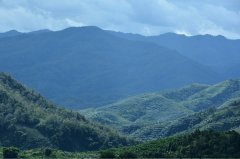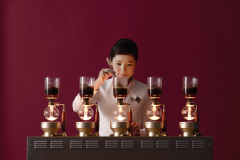2017 the most popular Colombian coffee-Finka. Coffee beans fermented in oak barrels of San Jose Manor at low temperature

For professional baristas, please follow the coffee workshop (Wechat official account cafe_style)
Basic information:
Country: Colombia
Producing area: Caldas province
Varieties: Castillo, Naranjal
Altitude: 1750 m
Manor: Finka. San Jose Manor
Flavor description:
Aroma: similar to the rum club with sweet sugarcane herbs, caramel, toffee and some micro-fruit aromas.
Palate: sugarcane herbal aromas and sweetness at the front, full toffee and caramel in the middle, and citrus in the end.
Sweet aromas of fruit, wood, almonds, toffee and candied fruit.
If it is to be described as wine, it is very similar to the flavor of zacapa 23 aged rum, because it is aged in the solera system.
Although it is rum, it has the flavor of Shirley barrel whisky.
(the above is the testimony from the alcoholic friend Xiao Guo)
Brief introduction:
Colombia's century-old manor ─ Finka. San Jose (Finca San Jose Estate) has been fine in recent years.
In the prevailing trend of coffee tasting, I have been actively trying to find a breakthrough for myself to take a different path.
Monsalve Botero, the hostess of Fenka San Jose Manor, specializes in rum oak barrels.
The husband who made and brewed rum, one day she had a whim that if she put the raw coffee beans in an oak barrel.
Fermentation, whether there will be a more different flavor. So, Monsalve Botero, she went from 2013
Began to try to use Colombian oak barrels for low-temperature fermentation of different lengths in 2000, and finally found a reason this year.
Think of the way, and then make the fermented beans in this oak barrel which is different from the ordinary water washing.
Above.
Personal experience:
When I first knew about this bean, there were only samples, which were already baked in Colombia.
Dozens of grams of beans, do not know what manor, do not know when to bake, what baking degree, only know
Tao is beans that have been treated in oak barrels. I don't even know whether the export certificate is available or not (I know that later.)
The samples have been baked for about two months, and the beans are baked until the beginning of the second explosion. At that time, I only felt
De: the aroma of this wine is too strong! It's so distinctive! Although the performance in the latter part was a little empty.
But because the information is so ambiguous, we can only wait and look forward to the baking skills of the landowner.
If the technique is not good, the flavor of the latter part of the beans will be better. It took some time before I knew.
More detailed raw bean information, export certificate is also available.
When the bean merchant told me more detailed information about the producing areas, it actually reminded me of Mr. Han Huaizong.
In the Facebook post, it was mentioned that ". His practice is to peel, take the shell beans without touching the water, and put them in the bucket.
Sealed to prevent flies from attacking, purely for health reasons, about 10 degrees Celsius in winter
The fermentation degumming is carried out at low temperature for two to three days, and then washed with water, which is mistakenly bumped into the method of low temperature and low oxygen fermentation.
. This is somewhat similar to the 2015 Australian barista Sasa Sectic's carbon dioxide impregnation method to win the championship.
That is, carbon dioxide produced by sugar fermentation helps anaerobes gain an advantage and produce during fermentation.
Raw acidity and aroma are superior to those of aerobic bacteria. Wang ce wins 2017 for Taiwan
The champion of the World Cup boiled beans also swung yuan by using the low temperature and oxygen-free sun drying technique of the Salvadoran post-maker.
. Low temperature anaerobic fermentation or fermentation to control oxygen content has become a new trend in the production of coffee in recent years.
Potential and illustrious learning. " (post link)
I think this Xingxu is the same, and San Jose Manor may not be the first one to do so.
But he created another strong flavor.
The first time I got the raw beans, the smell I smelled was' milk jujube', more or less wearing one.
A little grape and Chinese wolfberry flavor, but a complete general direction is ripe milk jujube, super
The sweet kind. And it always smells like that when baking.
Because it is Colombia, so in the first pot of baking, the choice is shallow baking, although the fruit
Incense and fermented incense are obviously suitable for shallow baking, but I still want to make a little thick. However, it is cooking.
After that, it was found that its flavor lost a little quickly in the middle and back of the baking. Although after raising beans,
The taste is still quite smooth and delicious, but the liveliness of the taste still can not come back. So make a decision right now.
The presentation after the decision is mainly shallow baking.
In addition, the performance in the cooking is also very special, the same freshly baked beans, the speed of passing water is special.
Fast, and when the exhaust is very exuberant, it will swell to half and suddenly bleed out. For this phenomenon
My guess is that it may contain very little oil, resulting in very small surface tension
Can not grasp the water, can not grasp the air.
As it happens, not long ago, Dr. Shao Changping Shao's Facebook post (post link) quoted from foreign countries.
The research data talk about the hydrolysis of lipids, forming acids and alcohols (original links), which are used to explain
Why there is a fermented taste like wine after the ice drop coffee is aged.
Therefore, I suspect that in the oak barrel of San Jose Manor, the lipids in the beans were already in the first place.
It is hydrolyzed into acids and alcohols, which is why it has such a full and rich flavor.
Here are two pieces of thick water column that I developed for the Melitta flat bottom filter cup.
After brewing, the original loose powder layer turns into a sinkhole-like collapse, which should be regarded as a sinkhole.
A corroboration of the aforementioned opinion.
Important Notice :
前街咖啡 FrontStreet Coffee has moved to new addredd:
FrontStreet Coffee Address: 315,Donghua East Road,GuangZhou
Tel:020 38364473
- Prev

Introduction of Ethiopian Red Cherry Project Korate Krette Sun Red Cherry Coffee beans
Professional baristas please follow the coffee workshop (Wechat official account cafe_style) Ethiopian Red Cherry Project Korate Krette Sun Bean operation Cherrie Red "Red Cherry Initiative" (ORC) is a project to improve the quality of small-scale farms, mainly to encourage soybean farmers and surprise roasters. Trabocca, the largest coffee bean seller in the Netherlands, invited the company before the harvest season.
- Next

The difference between hand-brewed Colombian coffee and siphon coffee Colombian coffee tastes good anyway.
Professional baristas follow the coffee workshop (official Wechat account cafe_style) it has been a long way to drink the best coffee in the world. First take the bus to the Armenian city (Armenia) from the bus transfer station on the west side of the Colombian capital Bogot, and then transfer to Salento after a nearly 10-hour drive.
Related
- Detailed explanation of Jadeite planting Land in Panamanian Jadeite Manor introduction to the grading system of Jadeite competitive bidding, Red bid, Green bid and Rose Summer
- Story of Coffee planting in Brenka region of Costa Rica Stonehenge Manor anaerobic heavy honey treatment of flavor mouth
- What's on the barrel of Blue Mountain Coffee beans?
- Can American coffee also pull flowers? How to use hot American style to pull out a good-looking pattern?
- Can you make a cold extract with coffee beans? What is the right proportion for cold-extracted coffee formula?
- Indonesian PWN Gold Mandrine Coffee Origin Features Flavor How to Chong? Mandolin coffee is American.
- A brief introduction to the flavor characteristics of Brazilian yellow bourbon coffee beans
- What is the effect of different water quality on the flavor of cold-extracted coffee? What kind of water is best for brewing coffee?
- Why do you think of Rose Summer whenever you mention Panamanian coffee?
- Introduction to the characteristics of authentic blue mountain coffee bean producing areas? What is the CIB Coffee Authority in Jamaica?

